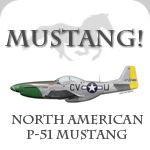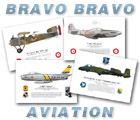French Mustangs
Immediately after the Allied landing in Algeria and Morocco, in November 1942, the French reconnaissance group II/33 Savoie took part in the Tunisia campaign with its obsolete Bloch 174 aircraft. Rumor had it that the group was to receive American F-5 Lightnings and F-6 Mustangs. The F-5s arrived starting March 1943 and were used by the first squadron. In September 1943, the Bloch aircraft of the group were withdrawn, leaving the second squadron with no mounts for three months.
Wishing for a Mustang
At first, the second squadron was supposed to be re-equipped with B-26 Marauders, and crews were sent to train on the type. Then the squadron was told it would operate B-25 Mitchells. Finally it was agreed that the squadron should become a tactical reconnaissance unit and was sent to St Donat on December 31, 1943 to take delivery of Hurricane IICs for training. Intensive conversion flights started with an average of 45 flight hours per day. Then, 9 Spitfire Mk Vs were delivered between March 15, 1944 and April 1, 1944. The unit was then based in Italy, providing support for the advance of the US 5th army towards Rome.
The unit operated successively from Pomigliano d'Arco, Santa Maria di Capua, Anzio Nettuno, Ponte Gallera, Tarquinia Voltone and finally Follonica in Corsica during the months of May and June of 1944. From there it participated in the invasion of southern France. On August 22, 1944 the Spitfires Mk IX landed at Ramatuelle in France, marking the long-awaited return to the native soil of the aircrews. The unit later moved to Saint Laurent-de-Mure, Dijon-Longvic and Luxuil-les-Bains, doing an important job of reconnaissance for the Allied armies advancing northward.
On November 14, 1944, Cdr. Marcel Martre took command of Groupe de Reconnaissance II/33, at a time when the squadron was flying numerous operations in difficult weather conditions. In two weeks, seven Spitfires were lost to accidents. Nevertheless, opportunities sometimes appeared, and the squadron managed to complete successful visual reconnaissance missions in cooperation with fighter-bombers.
On January 1, 1945, the two squadrons were reorganized by decision of the Armée de l'Air command. The first squadron, formerly the SAL.33 became the GR I/33 Belfort autonomous strategic reconnaissance group and kept its F-5 Lightnings. The second, GR II/33 Savoie, was to become a tactical photographic and visual reconnaissance unit and keep its Spitfires Mk V and IX. However, the Spitfires oprated by GR II/33 were considered inadapted to the missions the unit was expected to fly, and the Americans accepted to supply them with twenty P-51s. On January 10, 1945, nine pilots were assigned the task of ferrying the aircraft from Great-Britain and left on the 14 with two mechanics, Adj. Copitet and M/Sgt. Pruvost and Capt. Jenny Clark. These pilots were Capts. Laborderie, Guibaud, Latapy and Lts. Labadie, Rey, Chautemps, Callac, Lengellé and Villetorte.
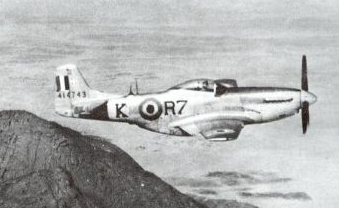 |
| This is F-6D 44-14743 seen flying over the In-Ecker range in Northern Africa between February and April 1946, while the group was tasked to map Northern Africa. This aircraft suffered two accidents: first on April 16, 1946 when it overturned on landing at Blida, and on July 3, 1952 it was written off at Breuillet. |
The first aircraft (s/n #43-7045) was delivered to the II/33 on January 16, 1945 (some sources say January 10), delivered to Luxeuil-les-Bains by an American pilot. It was not by far a new aircraft, with 228 hours of flight time. It was joined by two other ones in the two following days, flown in by Lts. Joseph Clark and Joseph Chesney of the 111TRS (some sources specify Chesney was not a pilot but a Packard technician). On January 19, seven of the nine pilots sent to England took off with their F-6s from Stansted, Essex, but had to turn back due to heavy fog. Lt. Labadie landed at Northolt but Lt. Roger Callac was reported missing on P-51C-10NT 44-10884. They finally took off the next day and reached France, though some aircraft had to land at Paris-Orly airport instead of Luxeuil-les-Bains.
By January 20, GR II/33 had 24 pilots, five Spitfire IXs, four F-6Cs and four F-6Ds, and a single Morane-Saulnier MS.500 Criquet. All of the Mustangs were conversions from P-51Cs or P-51Ds to F-6Cs or F-6Ds. None of them had IFF equipment and quartz for the SCR-522 VHF radio sets (a radio set evolved from the British TR1143 with a range of approx. 150 miles for an aircraft flying at 20,000 ft). In addition, two aircraft had no radio sets and no photographic equipment. The cameras were K-17, K-22 and K-24 models mounted in different ways depending on the Mustang type.
Some XIIth Tactical Air Command crews provided initial ground instruction, and pilots started their 10 to 15 hours training program on January 22, flying whenever weather conditions allowed it. Within a few days, ten pilots were certified on the Mustang. During this conversion period, missions were still being flown with the Spitfires.
The incomplete equipment of the aircraft was to be the source of conflicts between the French and th Americans. It has to be understood that the French Free military were in a particular position at the time. They were the "secondary" warriors of the time, with small numbers and totally dependant as far as material was concerned. They were quite sensitive about being involved in the fighting in France. Since the continental field repair depots were already overloaded, installation of the IFF and other missing equipment could only be done in Great-Britain. Therefore, their return to operational status was delayed, to the French pilots' dismay. In addition, bad weather was delaying their flight training (the runway at Luxuil-les-Bains was closed for a week after heavy snow falls on January 25), which included different phases representing about 15 hours of training per pilot: first handling, patrol training, shooting, vertical and oblique camera shooting.
By the end of January, the members of the Savoie group had yet not progressed in their conversion to the Mustang. In addition to the runway being covered with snow and the low overcast, Cdr. Martre, was not succeeding in obtaining photographic film for the K-22 cameras and the cristals needed to get the SCR-522 radio sets working. Happily, between the 4th and 11th of February, three other Mustangs (F-6C #42-103449 and #43-25169, F-6D #44-14494) were delivered. In addition, the quartz needed for the radio sets finally arrived at the same time. By mid-February, 18 reconnaissance Mustangs and their crews were ready to enter operational service, the Spitfires disappearing by March.
Call to combat
Their task was everything but easy, as the Mustang was confronted to serious difficulties for visual reconnaissance. Compared to the Spitfire, the aircraft had a very large turn radius, high speed and bad downwards visibility. In addition, it was vulnerable to medium and large-caliber artillery, and was not the ideal aircraft for low-level flight in flak-crowded skies. This meant that the Mustang was adequate in detecting movements on roads, rivers and railroads but had to rely on its cameras to detect small or camouflaged units. Nevertheless, the French pilots of II/33 were eager to fight on board the P-51. This is what the official squadron journal says: "Since Italy, we looked with envy on the Mustang. We had been promised the model. We had expected it by easter, but several months later, we were still flying in our Spits, superb fighters that were not adequate for reconnaissance. We had begun to give up hope when a young American pilot landed on our airfield and asks for GR II/33, to which he is promptly escorted. He was all surprised to find himself surrounded by enthusiastic pilots as soon as he told us the Mustang was for us."
The French P-51s flew their first operational sortie on February 19, 1945 to find themselves greeted by very heavy Flak, both German and French... An angry pilot wrote: "The flak is heavier and more accurate everyday, and by chance, our planes our fired upon by French anti-aircraft artillery. Even French fighters attack us and Lt. Chautemps returned to base with two 20 mm hits in the wing, one aileron missing, and two .30 cal hits in the engine". He had been attacked by a Spitfire of the Frech Groupe de Chasse GC II/7 Nice. Following this, local ground units were reminded of basic reconnaissance precautions in anti-aircraft defense.
On March 20, the II/33 registered its first loss with the Mustang. During a mission over the Black Forest, Lieutenant Labadie's aircraft, hit by flak, ran into the ground and exploded. Unknown to his wingman, Lt. Rey,who reported him killed in the crash, he had managed to bail out in time only to be captured by the Wermacht.
On March 24, the group moved from Luxeuil-les-Bains to Colmar, where it was caught by German heavy artillery fire on the night of March 29, which killed Lieutenant Boillot, a member of the famous Etampes aerobatics patrol before the war. The group was temporarily sent back to Luxeuil and missions were organized to locate and destroy the batteries. A few days later, the II/33 was back in Colmar to help the Allied armies cross the Rhine.
The group then worked in collaboration with the P-47Ds which were part of the 1er Corps Aérien Français led by General Gérardot. The Thunderbolts were responsible for air cover and support for the 1st French Army. In these missions the Mustangs first located the targets and then took pictures to evaluate the attacks led by the Thunderbolts. On March 29, they covered nearly 22 miles of the Rhine's right bank, from Karslruhe to Speer, for the 2nd French Army Corps, which was to establish a "beachead" on the other side of the river two days later.
Immediatly after the crossing, the Mustangs of the Savoie group were engaged in so-called "army corps reconnaissance missions", which, because of the very low overcast and necessity to fly very low, turned out to be very dangerous. On one such mission, on April 17, Lt. Sainflou and Lt. Delgue were jumped by a dozen Bf 109s. Lt. Sainflou narrowly escaped by diving at full military power towards the ground, but Lt. Delègue was never seen again. Luckily, Lt. Labadie returned to the group on April 23, having escaped from a prisoner convoy.
This is another view of the P-51D operated by the Amicale Jean-Baptiste Salis, one of France's greatest warbird collection. Notice the gull insignia painted under the cockpit, and the Savoie arms on the fin.The French Mustangs then played an essential role in the combats between units of the 1st French Army and remnants of three German divisions in the Black Forest. They were able to locate with precision the enemy units, thus allowing their encirclement and defeat. This action owed them the congratulations of General Béthouard, commander of the 1st French Army: "Warmest thanks for the most effective help your crews gave to the ground troops, particularly on April 25, when reconnaissance and attack aircraft played a capital role in stopping and destroying powerful enemy formations trying to escape from the Black Forest towards the east. Their intervention, which was almost instant and lasted all day, cost the enemy very heavy losses and forbid it any movement, allowing its encirclement and capture. Very large numbers of troops were captured: several thousand men, representing the remnants of three divisions."
As the end of the war was clearly in sight, the group was ordered to cease all operations on May 7, 1945.
Victory in Europe
Between November 13, 1944 and April 15, 1945, the group had logged 1,052 flight hours during 730 sorties. Between April 16, 1945, and May 8, 1945, VE-Day, the P-51s of the Savoie group flew 189 sorties representing 324 hours of flight, most being for long-range reconnaissance missions on the retreating Wermacht's communication lines. Since the reception of its Mustangs, the group flew 13 oblique photo-recon missions, shooting 860 pictures, including 660 during the complete photo coverage of the Rhine's right bank, 136 vertical photo-recon missions, with 4400 pictures shot, thus covering nearly 4500 km². This important aerial work had allowed the photo-interpretors to locate 15 radar stations, 41 heavy AAA guns, 685 medium or light AAA guns, 11 heavy artillery guns and 25 medium ones, 15 mortar guns, 314 automatic weapons, 42 strongpoints, 21 bunkers, 47 road barrages, 10 anti-tank trenches, 42 depots, 5 radio stations, nearly 50 trains, and over 400 railroad and road cuts.
On May 9, 1945, nine Mustangs of the GR II/33 took part in the VJ-Day flypast over the Champs-Elysées. In the following weeks, numerous flypasts were made, and the group was visited by a team of movie-makers for an upcoming production.
The unit's success resulted in the unit members being awarded 17 crosses of the Legion of Honour, one of France's highest decorations, 39 army recommendations, 7 air reconnaissance recommendations, 8 division recommendations, 26 brigade recommendations and 28 group recommendations. In addition, 14 American awards were given, including 4 Distinguished Flying Crosses.
On July 2, 1945, a recommandation signed by General de Gaulle awarded the II/33 the Croix de Guerre avec palme, France highest unit award, with leaf: "Under the orders of Commander Martre, the perfect model of a leader, the reconnaissance group Savoie performed during the winter period a most remarkable work of reconnaissance with minimal equipment which translated into more than a thousand hours of combat flight time and 750 tactical reconnaissance missions for the profit of the French Army."
With the return to peace, the group's pilots flew fewer hours, and often left their Mustangs to fly on captured German aircraft. They left Colmar for Fribourg on September 12, 1945, and we were replaced by pilots of the GR I/33 Belfort a few days later.
This is F-6D 44-14743 seen flying over the In-Ecker range in Northern Africa between February and April 1946, while the group was tasked to map Northern Africa. This aircraft suffered two accidents: first on April 16, 1946 when it overturned on landing at Blida, and on July 3, 1952 it was written off at Breuillet.From February 18 to April 17, 1946, the Mustangs of the II/33 were sent in Northern Africa to do the photographic mapping of the Sahara desert and the Sahel. In July, a detachment was sent to Cambrai to map out the Somme estuary.
By December 1947, the group had still 20 Mustangs on strength: 13 F-6Cs, six F-6Ds and a piggy-back F-6K. A month later, that number was down to 16, four Mustangs having been sent for storage in Rennes.
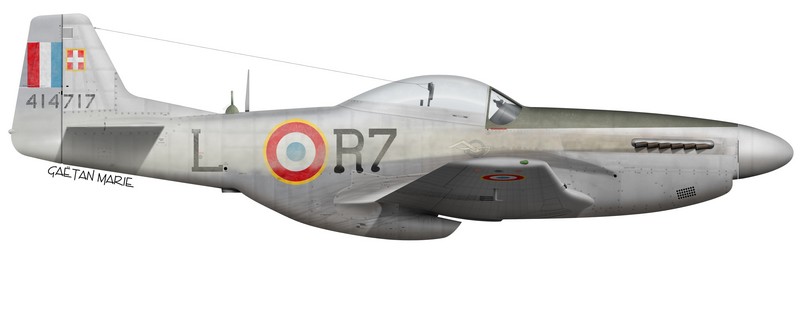 |
| A typical recce Mustang from the GR II/33 unit, F-6D-10-NA #44-14717 was received in February 1945, and had logged less than 22 flight hours. By the end of 1945, it bore a rugged look with extreme exhaust and oil staining. It carried the name of the French town Aix-les-Bains on the port side of the nose. |
By June 1947, mechanics were faced with a new problem. The canopies of the Mustangs were rapidly deteriorating, a classic problem with aging Mustangs, and several aircraft were declared non-operational. Group headquarters required canopies to be taken off from the aircraft stored in Rennes or from aircraft dur for delivery by the USAAF for use as spares. This took some time but eventually solved the problem.
In the spring of 1950, the Savoie group left for Cognac. An average of 16 aircraft available had been maintained, although accidents were still happening regularly. Flight hours were kept between 100 and 300 hours a month depending on conditions.
Mustangs were also allocated to the GR 1/33 Belfort group at the beginning of 1949 (From 1948, French units abandoned the roman notation of their units, using only Arabic numbers). By February 1949, the unit had four F-5Fs, ten F-5Gs and six F-6Cs. It was not until April that a pair of F-6Ds replaced some F-6Cs. At the end of December 1949, the group was operating four F-6Ds, and two F-6Cs, with one aircraft stationed permanently in Lahr and operated by the Escadrille de Liaison Aérienne (ELA) 55, operating as liaison aircraft for the the 1st Division Aérienne headquarters. Flight time in Mustangs decreased steadily until all GR 1/33 Mustangs were grounded in July 1950.
On the other hand, GR 2/33 kept flying its Mustangs extensively, with 200 to 300 hourls logged every month during 1951 and 1952. Attrition due to accidents was still too common, but the group still fielded 16 aircraft. In November 1951, the 2/33 left for Weisbaden to take part in the FTX51 combined maneuvers. They completed 78 sorties, flying 136 hours and taking 870 photographs.
However, the time of the Mustang was closing. In November 1952, the inhabitants of Cognac heard the roar of jet fighters for the first time: six F-84G Thunderjets were being delivered to the 2/33. Fron January 1953, the 16 F-6s still on strength flew less than ten hours a month, and none in June and July.Eight aircraft remained by September, and had all disappeared by October. All Mustangs were sent back to Rennes and then returned to the Americans who scrapped them. A few Mustangs were sent to Ambérieu for ground instruction, where their track was lost, marking the end of the type's career in the Armée de l'Air.
Colour schemes and markings
As far as can be seen, French F-6s were all natural-metal with the standard olive-drab or black anti-glare panels. The panel surrounding the exhaust stacks was sometimes painted black, though not always. The spinner was also generally painted in bright red, although not always. In some cases, the panel surrounding the intake under and behind the prop spinner was also painted red.
The GR II/33's gull insignia was generally found painted under the cockpit on both sides of the aircraft. The rudder usually bore a French flag, either a small rectangular flag, or the entire rudder being painted with the French national colours. In front of this, on the fin, the GR II/33 Mustangs generally had the arms of the Savoie region painted, with the unit's gull insignia painted under the cockpit on both sides. The gull insignia did not however appear on all aircraft. The GR I/33 Mustangs wore the same decorations, with the Savoie coat of arms being replaced by the unit's distinctive red axe insignia.
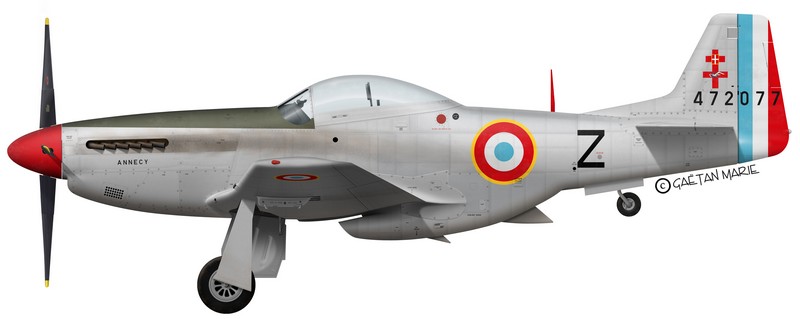 |
| P-51D-20-NA 'Annecy' was typical of GR II/33 Mustangs, except for the composite insignia on the fin: a red Lorraine cross with Savoie coat of arms and II/33 gull. The author is unsure wether the antenna located behind the canopy was painted red or black, both being possible. Also, it is unclear whether the forward air intake was painted red as well. © Gaëtan Marie. |
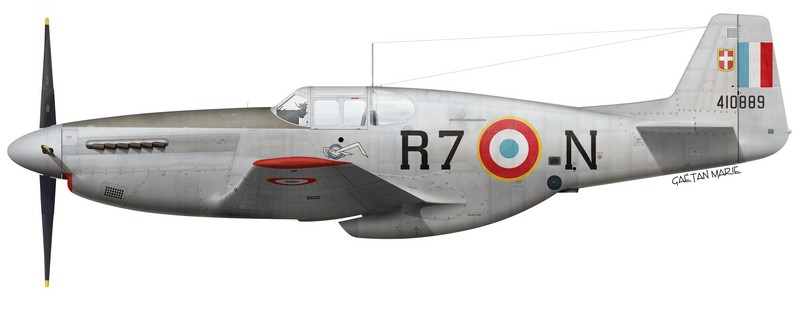 |
| P-51C-10-NT was delivered to GR II/33 in July 1944 and had only 16 hours and 15 minutes of total flight time, unlike most other Mustangs delivered to the unit. © Gaëtan Marie. |
At least 15 aircraft of the GR II/33 were given city names, generally painted in black capital letters under the exhaust stacks.
Sources:
- P-51 Mustang by Robert GRINSELL and Rikyu WATANABE, Editions Atlas (in french).
- P-51 Mustang in Action by Larry DAVIS and Don GREER, Squadron/Signal Publications.
- FRENCH MUSTANGS: The Armée de l'Air and the F-6 by Allain PELLETIER, Air Enthusiast magazine, Spring 1995, No 7.
Further reading :
This article was written by k51d. Version 2.2 Any addition or correction is welcome.
Advertising |
